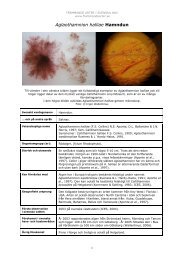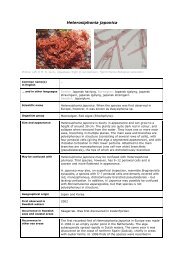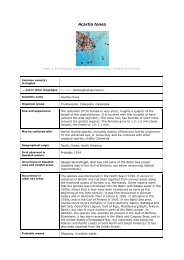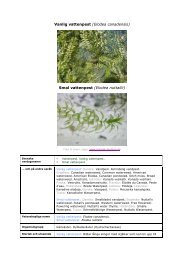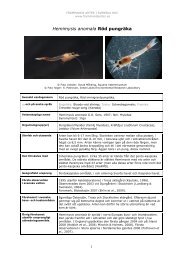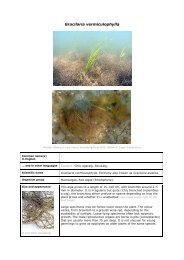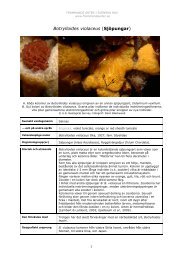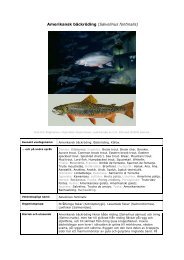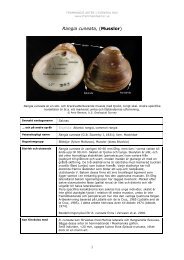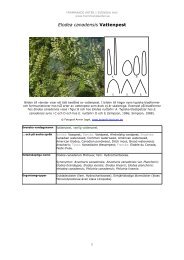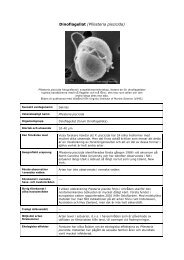Elodea nuttallii
Elodea nuttallii
Elodea nuttallii
Create successful ePaper yourself
Turn your PDF publications into a flip-book with our unique Google optimized e-Paper software.
Size and appearance<br />
Canadian waterweed: Has long, trailing stems that can grow to a<br />
couple of metres in length. The leaves, which are 6–15 mm long and<br />
1.5–4 mm wide, are arranged in whorls along the stem. The plant has<br />
white, thread-like roots. The white, single-sex flowers appear from<br />
July to September.<br />
Nuttall’s waterweed: Like Canadian waterweed, has trailing, metrelong<br />
stems. As in that species, the leaves are arranged in whorls, but<br />
here they are slightly shorter (6–13 mm) and appreciably narrower<br />
(no more than 1.5 mm), and they may be a somewhat paler green. In<br />
general, plants of this species are somewhat smaller and more<br />
“delicate” than Canadian waterweed.<br />
Both species: Male and female flowers are produced on different<br />
plants. So far, only female plants of the two species have been found<br />
in Europe. The species reproduce vegetatively by means of loose<br />
fragments and stem tips that disperse by water or are carried to new<br />
sites by birds or humans. Even tiny fragments can develop into new<br />
plants.<br />
May be confused with<br />
The two species may be confused with each other, but, as indicated<br />
above, Canadian waterweed (<strong>Elodea</strong> canadensis) has broader leaves<br />
than Nuttall’s (E. <strong>nuttallii</strong>). In Canadian waterweed, the leaves of the<br />
stem tip are broad and tongue-like, rather than narrow and strongly<br />
recurved. Nuttall’s waterweed has a more freely branched stem.<br />
Another difference between the species is that in Nuttall’s waterweed<br />
the male flowers (which admittedly are rarely produced) break off and<br />
float to the surface. Nuttall’s waterweed is still considerably rarer than<br />
Canadian waterweed, but seems to be spreading ever more widely in<br />
Europe and may even, in places, have the potential to outcompete its<br />
relative.<br />
A closely related species, Brazilian elodea or Brazilian waterweed<br />
(Egeria densa), is often sold for use in aquaria.<br />
Geographical origin<br />
Canadian waterweed: North America: Canada.<br />
Nuttall’s waterweed: North America (named after Thomas Nuttall, who<br />
studied the flora of the American West in the early 19th century).<br />
First observed in<br />
Swedish waters<br />
Occurrence in<br />
Swedish waters<br />
Canadian waterweed: 1871, in ponds in the Uppsala area.<br />
Nuttall’s waterweed: 1991, at Ängby near Stockholm.<br />
Canadian and Nuttall’s waterweed are freshwater plants, and do not<br />
occur in salt water or in brackish water too strongly affected by salt<br />
water (see below regarding habitats). Canadian waterweed is to be<br />
found, however, in Swedish and Finnish coastal waters of the Gulf of<br />
Bothnia, for instance in confined inlets in areas where marked<br />
postglacial crustal uplift is occurring.<br />
In fresh waters, Canadian waterweed is found widely across Sweden,<br />
from Skåne in the south to Dalarna in the north, with some<br />
occurrences even further north. Less is known about how common<br />
Nuttall’s waterweed is, but the species has been found in various<br />
freshwater bodies in Skåne, Västergötland and Norrbotten. In Lake<br />
Mälaren, this species is more abundant than Canadian waterweed.<br />
Occurrence in other<br />
areas (coastal or<br />
inland waters)<br />
Canadian waterweed: Was introduced to Europe from North America<br />
around 1840. It is reported to have been discovered for the first time<br />
in Europe in 1836, in a pond in Ireland, and six years later finds were<br />
made in Britain (Scotland). The first find in Germany was in 1859, in



